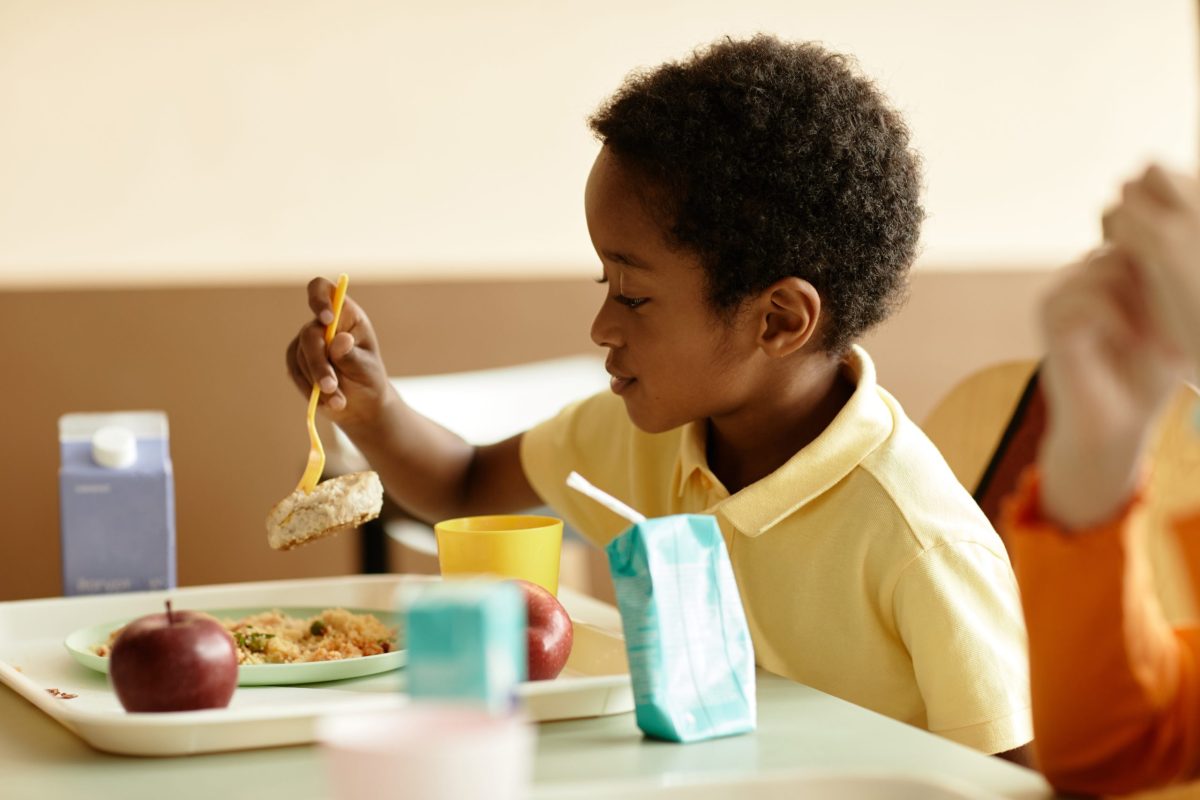Overview:
A federal judge in Rhode Island has ordered the Trump administration to use emergency funds to pay for the Supplemental Nutrition Assistance Program (SNAP) after the federal dollars for SNAP were expected to run out. The federal program helps 40 million households put food on the table, and about one in four Black households relies on SNAP to avoid food insecurity. Children from SNAP-eligible households will feel the impact of losing their monthly nutrition benefits, and schools and state leaders are stepping up to feed eligible students and families.
 Side view of smiling African American boy sitting at table enjoying eating lunch in school canteen, copy space Credit: SeventyFour
Side view of smiling African American boy sitting at table enjoying eating lunch in school canteen, copy space Credit: SeventyFour
This story was updated on Oct. 31, 2025, at 5:16 p.m. E.T.
A federal judge in Rhode Island ordered the Trump administration on Friday to tap into emergency funds to pay for the Supplemental Nutrition Assistance Program, just hours before the federal dollars for SNAP were expected to run out.
Sign up for our free newsletter to receive original, on-the-ground reports from the DFW area three times per week!
In an oral ruling, U.S. District Judge John McConnell Jr. ordered the United States Department of Agriculture to tap into contingency funds to fuel the SNAP program, according to Politico. McConnell’s order comes in response to several citizens and nonprofits that sued the USDA over not using emergency funds to support SNAP during the shutdown.
The federal government stated that it did not have the authority to use a contingency fund and lacked the funds to cover the cost of fueling SNAP benefits, Politico reported. Brooke Rollins, the agriculture secretary, didn’t say if she’d comply with the court order.
Federal funding for SNAP — the Supplemental Nutritional Assistance Program, which helps 40 million households put food on the table — was set to run out on Nov. 1 because Democrats and Republicans are locked in a stalemate over funding the federal government. And President Donald Trump has so far refused to transfer money from a contingency fund to keep the program afloat for the next few weeks.
RELATED: For the First Time in History, SNAP Will Be Interrupted
Pamela Ann Koch, an associate professor of nutrition and education at Columbia University, says that children from SNAP-eligible households will feel the impact of losing their monthly nutrition benefits. Those negative emotions, she says, likely will spill over into their academic lives.
“Children absorb everything that is going on around them, so they feel that stress too,” Koch says. “So on top of not having enough food, they are also going to recognize the hardship that their family is going through, and when they’re worried about that, how can they show up at school and be ready to learn everything that they are going to learn?”
About one in four Black households relies on SNAP to avoid food insecurity, according to data from the Economic Policy Institute.
RELATED: As SNAP Benefits Stall, Black Churches Step Up to Feed America
The federal program, started in 1939, has been responsible for helping feed millions of Black children burdened with food insecurity. In 2023, 14% of Black households with children and 14% of Hispanic families with children experienced food insecurity — a share far higher than the roughly 6% rate for white households.
Mountains of research have pointed to how students coming from food-insecure homes struggle in school. Poor performance and dips in school attendance are just some of the setbacks of not having enough or any food in your home.
What About Free School Meals?
Free school meals help stave off the adverse effects of food insecurity. Schools that enroll in the Community Eligibility Provision — a program that allows schools that serve a sizable share of children from food-insecure households to provide free meals — can offer free breakfasts and lunches to all students if at least 25% of a school’s student body qualifies for free meals.
RELATED: Faith Groups Lead Fight Against Hunger.
However, Koch says that free school meals might not be enough to sustain hungry children throughout the entire day.
Schools that serve free meals typically meet only a third of the daily caloric intake their students need. Even if students could obtain a third meal through an afterschool program, it would be “just barely enough” to meet the recommended nutritional requirements, Koch says.
With SNAP benefits about to lapse for the first time in the federal program’s 86-year history, schools and state leaders are stepping up to feed eligible students and families.
RELATED: USDA Warns States About November SNAP Benefits
A middle school in New York City’s Chinatown neighborhood is reviving a food pantry where families struggling with food insecurity can receive a bag of groceries on a biweekly basis, according to Chalkbeat. Another school in Brooklyn, where 85% of students are from SNAP households, has set up a GoFundMe page to purchase grocery store gift cards and stockpile basics that they’ll give out to students throughout the day.
Meanwhile, New York Gov. Kathy Hochul said she is considering using schools to send more food home to families in need.
Illinois Gov. JB Pritzker and Massachusetts Gov. Maura Healey have both taken steps to inject millions of dollars into their respective states’ food banks ahead of Nov. 1. Both democrats join a handful of other states, which include West Virginia, Rhode Island, California, and New Mexico, that are trying to do the same.
This story was originally published on Word In Black on October 31st, 2025
Support Our Work
With the support of readers like you, we can continue to create thoughtfully researched articles for a more informed and connected community.
Related
